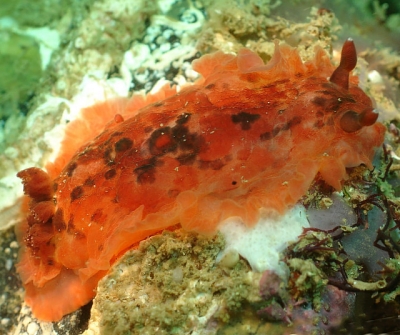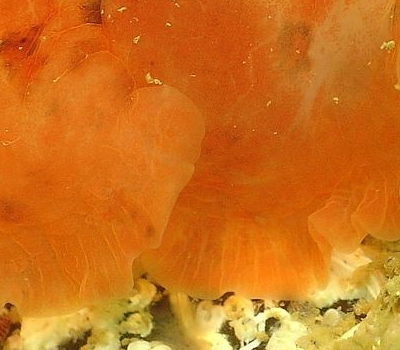Re: Dendrodoris grandiflora from southern Portugal
July 14, 2006
From: Marina Poddubetskaia Ossokine

Concerning message #17106:
Dear Carlos and Bill,
The red animal surprised me because I have an almost identical photo but from Senegal, identified for now as Dendrodoris senegalensis. As you can see in attached here photos, there isn't any external difference and even the mantle border is similar, with the pattern of branching lines present in both animals.
Locality: 'Cap Manuel', Dakar, 4m, Senegal , Atlantic Ocean, 2 June 2005 . Length: 55mm. Photographer: Marina Poddubetskaia Ossokine.
So, I'm wondering if Dendrodoris senegalensis could be a junior synonym of Dendrodoris grandiflora? Moreover, I have already found black D. senegalensis and uniform red juveniles. And when I wrote my first messages to the Forum about the Senegalese Dendrodoris I noted their similarity to D. grandiflora.
Bill, please could you give your opinion on these species.
Best wishes,
Marina.
Nembro website
nembro@nembro.info
Poddubetskaia Ossokine, M. , 2006 (Jul 14) Re: Dendrodoris grandiflora from southern Portugal. [Message in] Sea Slug Forum. Australian Museum, Sydney. Available from http://www.seaslugforum.net/find/17131
Dear Marina,
I agree with your puzzlement. All I can go on is the latest comprehensive study (Valdes, et al, 1996) which reviewed the Atlantic species. Angel Valdes comments on the northeastern species in an earlier message [#2461] but does not include a discussion about 'lookalikes' of D. grandiflora. That study gives the distribution of D. grandiflora as the Mediterranean and the Atlantic coast from Portugal south to Mauritania, and out to the Canary Islands. D. senegalensis, they say, is only known from Senegal.
My feeling is that some European workers still have a fairly eurocentric view of the world. Where as I would feel quite comfortable with a species extending from southern Europe down the west coast of Africa, they are more comfortable with a European species and a few similar but distinct species from surrounding regions. Defining species of Dendrodoris is difficult because one of the main characters we use in other dorid families - the radula - is absent. Valdes et. al. consider the shape of the spines on the penis to be a useful character in separating species of Dendrodoris but I must say I am less sure of their usefulness. They consider these two species can be separated on spine shape, D. grandiflora having a large base and D. senegalensis having a narrow base. However there is so much variation in spine shape and base size in the spines of just one penis of one species, that I find this a very shaky character on which to separate species.
We have similar problems with the Indo-West Pacific species D. nigra and D. fumata, where there is considerable colour variability within the species, and colour similarity between species. And like the Atlantic species, they start as red juveniles and change to their adult colour pattern as they develop. I suspect we will have to wait until DNA testing is sophisticated enough to give us unambiguous answers, but at present I think we should continue to build up observations on their biology and natural history - what are their eggs and egg ribbons like, what sponges do they feed on etc?
-
Valdes, A., Ortea, J., Avila, C. & Ballesteros, M. (1996) Review of the genus Dendrodoris Ehrenberg, 1831 (Gastropoda: Nudibranchia) in the Atlantic Ocean. Journal of Molluscan Studies, 62: 1-31.
Best wishes,
Bill Rudman
Related messages
-
Dendrodoris senegalensis (?) from Senegal
From: Marina Poddubetskaia, July 7, 2003 -
Dendrodoris senegalensis - juveniles
From: Marina Poddubetskaia, July 6, 2003 -
Dendrodoris senegalensis
From: Bill Rudman, July 6, 2003 -
Adult Dendrodoris senegalensis from Senegal
From: Marina Poddubetskaia, July 6, 2003 -
Dendrodoris senegalensis - subadults
From: Marina Poddubetskaia, July 6, 2003
